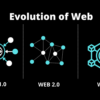What is changing with Web.3?
Analyzing emerging technological, commercial and societal trends allows you to anticipate and prepare for possible futures. This exploratory role would allow to get a head start in identifying innovative ideas and assessing their potential, before eventually integrating them into the company on a larger scale.
Most people think of the Web as a continuous pillar of modern life — it was invented and has just existed since. However, the Web most of us know today is quite different from originally imagined. To understand this better, it’s helpful to break the Web’s short history into loose periods — Web 1 and Web 2.
Web 1 From Read-Only: 1990–2006
In 1989, at CERN, Geneva, Tim Berners-Lee was busy developing the protocols that would become the World Wide Web. His idea? To create open, decentralized protocols that allowed information-sharing from anywhere on Earth. The first inception of Berners-Lee’s creation, now known as Web 1, occurred roughly between 1990 to 2004.
Web 1 was mainly static websites owned by companies, and there was close to zero interaction between users — individuals seldom produced content — leading to it being known as the read-only web.
Web 1 was the first iteration of the web. Most participants were consumers of content, and the creators were typically developers who build websites that contained information served up mainly in text or image format. Web 1 lasted approximately from 1991 to 2004.
Web 1 consisted of sites serving static content instead of dynamic HTML. Data and content were served from a static file system rather than a database, and sites didn’t have much interactivity at all.
You can think of Web 1 as the read-only web. Users as consumers of content.
Web 2 Community based platform — a two-way system: 2004 to the present
The Web 2 period began in 2004 with the emergence of social media platforms. Instead of a read-only, the web evolved to be read-write. Instead of companies providing content to users, they also began to provide platforms to share user-generated content and engage in user-to-user interactions.
As more people came online, a handful of top companies began to control a disproportionate amount of the traffic and value generated on the web. Web 2 also birthed the advertising-driven revenue model. While users could create content, they didn’t own it or benefit from its monetization.
This has been a period of centralization, as for-profit tech companies — most notably GAFAM (Google, Apple, Facebook, Amazon, Microsoft) — built software and services that rapidly outpaced the capabilities of open protocols. For example: Simple Mail Transfer Protocol (SMTP) is an open protocol that enables email. Google owns Gmail and Microsoft owns Outlook, but no one company owns the email-enabling protocol itself. However, in many cases, these closed protocols are not tech companies’ core business: individuals don’t pay Google to use Gmail, but instead Gmail feeds into Google’s core business of collecting data and selling ads. This is the world of Web 2. As the saying goes: “If you’re not paying for it, you’re not the customer. You’re the product.”
Users as producers of content.
Web 3 Decentralization & Individual-based: from 2016
Although it’s challenging to provide a rigid definition of what Web3 is, a few core principles guide its creation.
- Web3 is decentralized: instead of large swathes of the internet controlled and owned by centralized entities, ownership gets distributed amongst its builders and users.
- Web3 is permissionless: everyone has equal access to participate in Web3, and no one gets excluded.
- Web3 has native payments: it uses cryptocurrency for spending and sending money online instead of relying on the outdated infrastructure of banks and payment processors.
- Web3 is trustless: it operates using incentives and economic mechanisms instead of relying on trusted third-parties.
Web 3, also known as Semantic Web or read-write-execute, is the era that alludes to the web’s future. Artificial Intelligence (AI) and Machine Learning (ML) enable computers to analyze data in the same way that humans do, which aids in the intelligent generation and distribution of valuable content according to a user’s specific needs.
Web 3 apps are built on blockchains, decentralized networks of numerous peer-to-peer nodes (servers), or a hybrid of the two. These programs are known as decentralized apps (DApps). Network participants (developers) are rewarded for delivering the highest quality services to establish a stable and secure decentralized network.
Web3 isn’t difficult, but it is different:
- Ownership: Web3 gives you ownership of your digital assets in an unprecedented way. Web3 allows for direct ownership through non-fungible tokens (NFTs).
- Censorship resistance: No one can block you. On Web3, your data lives on the blockchain. When you decide to leave a platform, you can take your reputation with you, plugging it into another interface that more clearly aligns with your values.
- Identity: Web3 solves problems by allowing you to control your digital identity.
- Decentralized autonomous organizations (DAOs): As well as owning your data in Web3, you can own the platform as a collective, using tokens that act like shares in a company. DAOs let you coordinate decentralized ownership of a platform and make decisions about its future.
- Identity: Web3 solves problems by allowing you to control your digital identity.
- Native payments: Web2’s payment infrastructure relies on banks and payment processors. Web3 uses tokens to send money directly in the browser and requires no trusted third party.
Sources : Ethereum, Andreessen Horowitz





